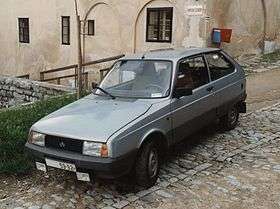Oltcit Club
| Oltcit Club | |
|---|---|
 | |
| Overview | |
| Manufacturer | Oltcit |
| Also called |
Citroën Axel Oltcit Special Oltena Club |
| Production | 1981–1995 |
| Assembly | Craiova, Romania |
| Body and chassis | |
| Class | Supermini |
| Body style |
3-door hatchback 2-door pick-up |
| Layout | Front-engine, front-wheel-drive |
| Powertrain | |
| Engine |
652 cc flat-2 air-cooled 1129 cc flat-4 air-cooled 1299 cc flat-4 air-cooled |
| Transmission | 4 and 5-speed manual |
| Dimensions | |
| Wheelbase | 2,370 mm (93 in) |
| Length | 3,732 mm (146.9 in) |
| Width | 1,538 mm (60.6 in) |
| Height | 1,430 mm (56.3 in) |
| Curb weight | 835–875 kg (1,841–1,929 lb) |
The Oltcit Club was a supermini automobile developed by Oltcit in co-operation with Citroën of France in the 1980s. It is a small three-door hatchback, based on the Citroën Prototype Y and was built in Craiova, Romania.
Development history
From 1965 Robert Opron worked on the Citroën G-mini prototype and projet EN101, a replacement for the 2CV, using the flat twin engine from the 2CV. It was supposed to launch in 1970. The advanced space efficient designs with very compact exterior dimensions and an aerodynamic drag co-efficient Cd of 0.32, were axed because of adverse feedback from potential clients.[1]
The Citroën Prototype Y to replace the 2CV based Citroën Ami that dated back to 1960 in the early seventies, was originally developed in co-operation with Fiat, built on the lessons from the Citroën G-mini and EN101 projects. It used the then new and advanced Fiat 127 platform, that used a transverse front wheel drive engine, with an end on gearbox layout that Fiat had pioneered in the 1960s. When cooperation with Fiat ended, a new Citroën designed platform was planned. After the takeover of Citroën by Peugeot in the wake of the 1974 oil crisis, the renamed "Projet VD (Voiture Diminuée)" became the Citroën Visa, incorporating the floor pan of the Peugeot 104, to use the advanced 104 engine, with transmission (under the engine) and chassis.[2] It was the first new model under the platform-sharing policy of PSA Peugeot Citroën that continues today. The earlier Citroën LN was just a facelift of the Peugeot 104Z "Shortcut" with a re-engine and transmission from the Citroën Dyane. Eventually, in 1984, the original Citroën platform design from "Project Y" emerged as an Oltcit in Romania, using a Citroën Visa flat-twin engine and Citroën GS based gearbox, and Citroën GS flat-four engine and gearbox, and was also sold in Western Europe as the Citroën Axel to recoup money that Citroën had invested in Romania, that the communist government couldn't repay. This project was problematic for Citroën due to build quality issues, only 60,184 Axels were made, even though the base models were priced below the 2CV in Western Europe. The Axel was never sold in the UK.
Production
.jpg)
The Oltcit Club carried on with the Prototype Y-derived design and was sold between 1981 and 1996. It was also sold in Western Europe, Canada, and other markets, often badged as the Citroën Axel.
In 1991, as a result of the withdrawal of Citroën from the joint venture, the name of the manufacturing company was changed to Automobile Craiova and production continued under the Oltena brand.
After 1994, it was sold under the Rodae brand, when the company decided to go into partnership with Korean company Daewoo Heavy Industries (later Daewoo Motors).
Engines
| Name | Capacity (cc) | Type | Power | Torque | Top speed | Consumption (liters/100 km) |
|---|---|---|---|---|---|---|
| VO36/630 | 652 | air cooled flat twin, OHV | 34 PS (25 kW; 34 hp) @5250 rpm | 49 N·m (36 lb·ft) @3500 rpm | 121.2 km/h (75.3 mph) | 6.8 litres per 100 kilometres (42 mpg-imp; 35 mpg-US) |
| G11/631 | 1129 | air cooled flat 4, SOHC | 57.4 PS (42 kW; 57 hp) @6250 rpm | 79 N·m (58 lb·ft) @3500 rpm | 149.4 km/h (92.8 mph) | 8.1 litres per 100 kilometres (35 mpg-imp; 29 mpg-US) |
| T13/653 | 1299 | air cooled flat 4, SOHC | 61.5 PS (45 kW; 61 hp) @5500 rpm | 96 N·m (71 lb·ft) @3250 rpm | 157 km/h (98 mph) | 7.3 litres per 100 kilometres (39 mpg-imp; 32 mpg-US) |
Models
- Oltcit Special (652 cc)
- Oltcit Club 11 (1129 cc)
- Oltcit Club 12 TRS (1299 cc)
- Oltcit Club 12 CS (Pick-up version) (1299 cc)
See also
References
- ↑ http://www.citroenet.org.uk/prototypes/g-mini/g-mini.html
- ↑ "Projet Y - Citroënet". Retrieved 2010-01-07.
External links
| Wikimedia Commons has media related to Oltcit vehicles. |
- Oltcit (Citroen Axel) in Romanian
- Oltcit, Oltena and Axel at Citroenet